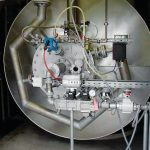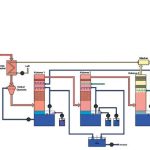Production processes in a multi-purpose pharmaceutical system result in flows of exhaust air which may contain substances in varying compositions and concentrations. Moreover, explosive mixtures are involved. Using the exhaust gas cleaning system described below, these exhaust gas flows – which are very heterogeneous in terms of volume and composition – can be disposed of safely, permanently and economically.
Dr. Walter Hilgert
A wide range of different pharmaceutical substances are manufactured on the site. Parts of the system are additionally used to develop new products. This results in toxic mixtures which are also subject to explosion protection regulations. The exhaust air treatment process must ensure that both these and the German Clean Air regulations (TA-Luft) are complied with without impairing production and research activities. The exhaust air treatment process must render all possible combinations of pollutants harmless. The production site is in the middle of a residential area.
The exhaust air cleaning system consists of the following main components: conditioned fabric filter to safeguard detonation protection devices, devices to protect against explosion, vertical thermal oxidation chamber for organic compounds, radiation heat exchanger to reheat cleaned exhaust air, Venturi quencher and multi-stage wet scrubber. The exhaust air is classified under Explosion Zone 0. Zone 0 is a place in which an explosive atmosphere consisting of a mixture with air of dangerous substances in the form of gas, vapour or mist is present continuously or for long periods or frequently. Since the flame in the thermal oxidation chamber is a constant source of ignition, a flashback may occur in the exhaust gas against the direction of flow right up to the production systems. For this reason, protective measures must be in place. One method of preventing the formation of hazardous explosive atmospheres would be, for example, to limit concentration levels by dilution. The exhaust air volume is increased by mixing in ambient air, so that the pollutant concentration is no more than 25 % of the LEL (lower explosion limit). In this case, the exhaust air volume will be nearly quadrupled. The investment and operating costs for the exhaust air cleaning system would be enormous, not to mention the space requirement.
The exhaust air cleaning concept described in this article envisages a direct supply of exhaust air to the thermal oxidation chamber. Several safety devices are used to prevent an explosion. Three independent so-called major safety devices are neces-sary for exhaust air classified under Zone 0. A major safety device is a system whose operation is assured at all times and whose functional criteria are monitored and measured by means of automatic switching functions. One dynamic and two static barriers are used as major safety devices:
- Flashback-free introduction of exhaust air into the thermal oxidation chamber
- Use of an explosion protection device
- Use of a deflagration protection device
A fan is used to convey the exhaust air from the handover point to the thermal oxidation chamber for Zone 1 according to VDMA 24 169 (German Engineering Federation regulations). The explosion protection measures are backed up, monitored and assured by the process control system, which includes a fail-safe PLC.
Thermal oxidation
Oxidation of the organic matter takes place in a thermal oxidation chamber. The heart of this chamber is a special muffle burner. The natural gas fuel is introduced axially to the burner via a nozzle lance. A double shell is used to supply the combustion air to two rows of nozzles arranged at the periphery, which force it diagonally into the reaction muffle; natural gas and combustion air are then mixed thoroughly, so that the combustion process is spontaneous and stoichiometric. A laminar flame front does not occur with this burner in the conventional sense. There is instead a spatial reaction with a turbulent flame and a high energy conversion density. The flow of exhaust air from the production and pilot plant stations is fed to the combustion chamber using four lances and the exhaust air from the chemicals storage using one lance. The command variable for combustion is the temperature in the thermal oxidation chamber, which is controlled in parallel by two thermocouples, whereby a measurement always intervenes in the control process. It was observed that the explosion protection devices were contaminated by very fine particles from the production process. To avoid extensive cleaning of these valves, the system was fitted with a conditioned fabric filter. The filter material and the operating parameters were selected taking account of the highly adhesive properties of the extremely fine dust. The conditioning agent was chosen so that it does not react with components from the gas phase. A very low filter surface load ensures the system’s availability and user-friendliness.
Wet scrubbing
The exhaust air from the combustion process is cooled in a radiation heat exchanger and a hot gas Venturi quencher. The inorganic pollutant gases and aerosols are separated in a three-stage wet scrubber. The heat that is released heats the cleaned exhaust air to over 100 °C upstream of the stack, so that a visible plume is avoided.
The experience gained from long-term operation of the entire system in many individual and combined load ranges (volumetric flow rates from <100 (NZ) to 1000 m³/h (NZ), low loads to explosion-protected operation and individual train or collective extraction) confirms that this system of concentrated parameters is highly effective (as an alternative to dilution by adding secondary air) – not only due to its robust operational performance but also because of its flawless emission values. Lufttechnik Bayreuth also offers process solutions for low and very low volumetric flow rates of exhaust air (approx. 10 Nm³/h). This example demonstrates how such solutions can be realised by means of collaborative and carefully coordinated (pre-)engineering and a synergetic combination of individual components that have been tried and tested many times over, even though at first sight they appear to call for a considerably larger exhaust air cleaning system.
cpp 422
More on thermal oxidation
German Clean Air regulations
Share:








